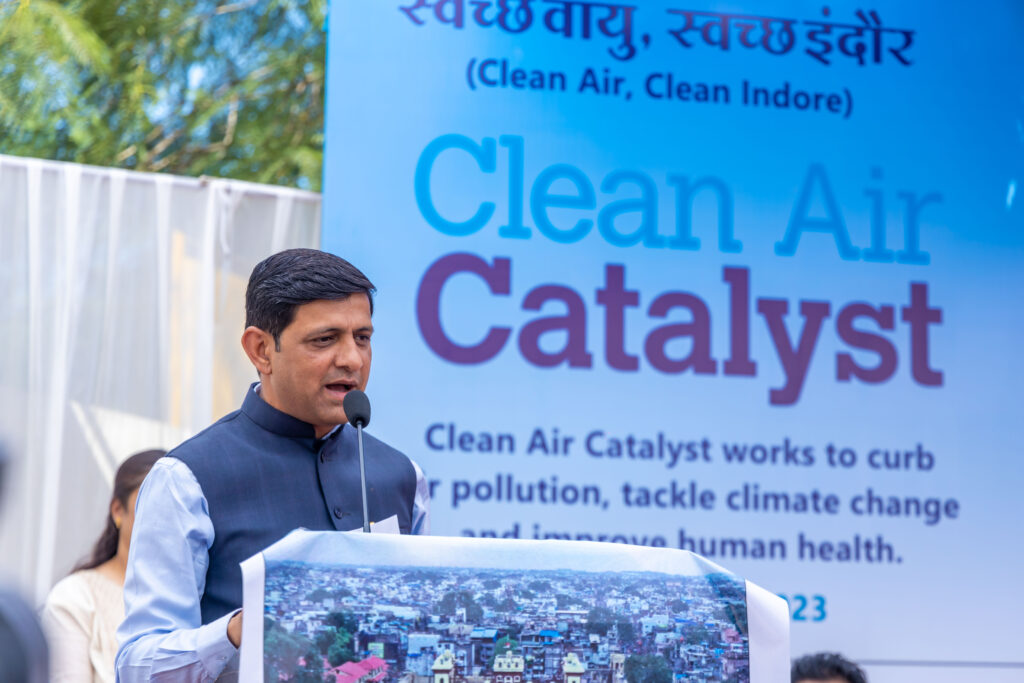
Indore is known as India’s cleanest city, having secured the title seven years in a row in Swachh Bharat National Cleanliness Surveys, and it is now determined to clean its air too. On February 15, the “Clean Air, Clean Indore” campaign was endorsed by the city’s mayor at the unveiling ceremony of three state-of-the-art monitoring stations that will provide highly accurate data on local sources of air pollution and help inform strategies to improve air quality “Like the moon, which has its blemishes, the city of Indore also has been facing two issues: its air quality and the traffic,” Mayor Pushyamitra Bhargav said at the ceremony held at one of the monitoring sites located at the Malav Kanya Higher Secondary School. “These two concerns have been added to my list of priorities, and the opening of the three new air quality monitoring sites operated by the Clean Air Catalyst is a step in the right direction.”
Collaboration on the “Clean Air, Clean Indore” Campaign
The goal of “Clean Air, Clean Indore” has been set by the Indore Municipal Corporation (IMC). To understand what it means and what efforts are being made to achieve it, we must look to a letter issued on July 1, 2016, by the Central Pollution Control Board. Indore was named 1 of 132 non-attainment cities because it did not meet the prescribed national ambient air standards for five consecutive years (2011-15). India’s National Clean Air Programme (NCAP) standards look to reduce particulate matter concentration by 40% in cities covered under the NCAP by 2026, updating the earlier goal of a 20-30% reduction by 2024.
Indore’s efforts to clean its air received a significant boost in 2020 when the Clean Air Catalyst program launched in collaboration with the IMC. The Catalyst is supported by the United States Agency for International Development (USAID) and co-led by WRI and the Environmental Defense Fund.
According to USAID Mission Director to India Veena Reddy, “In India, USAID is developing local solutions with the government, communities and the private sector to reduce greenhouse gas emissions and air pollutants, for better health, prosperity and environment. USAID hopes that improved data through these stations will support Indore’s efforts to improve air quality and spur other cities and policymakers to take further action.”
“Indore has a long history of influencing other cities and countries,” added Hisham Mundol, Environmental Defense Fund chief advisor, India. “What Indore has done on the ground with Swachh Bharat, what Indore has done to water plus, and what Indore will do on the air… we all look forward to that.”
Indore also has a history of collaborating with global partners to achieve its growth and development goals. Sree Kumar Kumaraswamy, program director for air quality action at WRI India, recalled, “We have had a long-term relationship with Indore. Fifteen years ago, we were involved in building the bus rapid transit system and since then we have been working on various projects on the environment and helping the IMC with various projects.”
Understanding Indore’s Air
With the inauguration of three new air quality monitoring stations in Indore, the Catalyst will collect air quality information to study and understand the composition and levels of various pollutants in the city’s ambient air. The goal is to better understand the sources of air pollution, the impact on the lives of residents, and devise strategies aimed at improving air quality to protect those most affected while simultaneously improving public health and the environment.
The reference grade equipment will measure levels of fine particulate matter, tiny particles that can be inhaled and cause serious health problems, like heart attacks, stroke, cancer, bronchitis and asthma. Equipment at Malav Kanya School will also measure levels of black carbon, a short-lived climate pollutant that warms our planet and harms our health, as well as carbon monoxide, another hazardous pollutant. In the last two years the Catalyst has also conducted field visits to Indore to survey emissions from pollution sites and perform a source apportionment study using data and modeling to better understand the contribution of various sectors and industries, such as transport, road dust, construction and waste burning. At present, the science team is preparing a report on their findings and in the coming two years will make recommendations and support the implementation of solutions with local partners.
“We hope we will be able to achieve our goal with the support from the NGOs, Asha workers, environmentally sensitive citizens and schools. The eco clubs in schools can help in changing the behavior among the students and the families. We hope we can reduce air pollution in the city and become an example for others,” said Kumarswamy.
The air quality monitoring station inauguration ceremony was also a celebration to commemorate the successful collaboration of the Catalyst and the local administration, civil society, Indore Municipal Corporation, industry, health sector and educational institutes for the last two years.
Learn more about the Clean Air Catalyst’s approach to creating solutions in Indore, and in two other pilot cities, Jakarta and Nairobi, at cleanaircatalyst.org.
Clean Air Catalyst is a global partnership supported by the U.S. Agency for International Development and led by World Resources Institute and Environmental Defense Fund, Inc. focused on building capacity for locally tailored solutions that curb air pollution, tackle climate change and improve human health. Catalyst partners include the Columbia Climate School Clean Air Toolbox for Cities, Climate and Clean Air Coalition, Internews, MAP-AQ, OpenAQ and Vital Strategies.
A version of this article originally appeared on CleanAirCatalyst.org.
Sudhir Gore is Clean Air Catalyst’s Indore Media Consultant for Environmental Defense Fund.








